Looking at a lineup of the Egyptian pantheon, you may feel like you’re being watched. Don’t make any sudden moves now! Just kidding, it’s nothing to worry about – that’s just the cat gods. Unless…you haven’t committed any crimes recently, have you?
Those are protective deities, you know. They don’t take kindly to wrong-doers. If you’ve done anything legally questionable within the last 24 hours then…maybe you should go. Maahes is looking a little hungry and Mafdet is filing her nails; the last time she did that it took us a week to clean to floors.
In all seriousness, no other face jumps out at you amongst the ancient Egyptian gods and goddesses than that of a cat. Cat gods are prominent in most world cultures, though their fame is undoubtedly from the abundance of feline artifacts discovered over the centuries in Egypt. The respect and affection ancient Egyptians had for cats were well-known even back in their heyday.
Part of such reverence stems from the ancient Egyptians viewing cats (and other animals) as vessels for the gods. The other part is because…just look at them! Keep reading below to learn all you can about the Egyptian cat gods.
Table of Contents
Did the Ancient Egyptians Worship Cats?
We’ve got to debunk the age-old belief that ancient Egyptians worshipped cats. So, here it goes: the ancient Egyptians did not worship cats, folks. Not in the way it is usually depicted.
Feline veneration is obvious based on existing archaeological evidence from ancient Egypt. We got that much. There are mummified cats, cat hieroglyphs, and cat statuettes. With an abundance of these furballs all over the place, something has got to give, right?
As it turns out, cats were very popular domestic pets from the New Kingdom (1570-1069 BCE) onwards.
READ MORE: Ancient Egypt Timeline
Wanting a beloved pet to be buried with oneself to accompany them in the afterlife isn’t far-fetched. It would also explain why there are so many tomb paintings of cats being…well, cats. The ancient Egyptians honestly just really loved these fierce felines.
Though before cats became adored pets, they were viewed as the kin of Bastet, the ultimate Egyptian cat goddess. Bastet was believed to take the form of a cat on occasion, thus it must’ve meant that cats were special in some way. Therefore, ancient Egyptians believed that the cat and its characteristics were worthy of praise.
Cats had undeniably admirable traits. They caught rodents and other pests that could pose a significant threat to early farming societies like those in ancient Egypt. In the days when rats could cause a societal collapse and when poisonous reptiles posed a serious threat, having a cat on hand was incredibly beneficial. Also, having a cat purr when you pet it is enough to just be ready to dedicate your life to it forever.
Can we blame the early Egyptians? The easy answer is no, we cannot.
The tenacity, capability, and shameless affection of these early felines cemented their role in the communities throughout the Nile River Valley.

How were Cats Worshipped in Ancient Egypt?
Again, cats weren’t necessarily worshipped. They were not considered divine beings themselves as much as they were the vessels of the gods. In a way, the general habits and behaviors of these early cats were shared with those of feline deities. You’ll notice a trend that the Egyptian cat gods share many traits with plain ol’ cats.
For example, cats are nurturing, so Bastet and Mut are nurturing; cats are protective, so Sekhmet and Mafdet are protective; cats have a penchant for brutality, so Sekhmet, Mafdet, and Maahes have cruel streaks. This overlap blurs the line a bit when attempting to separate social exaltation from religious veneration. With all things in mind, cats were highly regarded in ancient Egypt.
Cats in ancient Egypt were so adored that the Persian king Cambyses II exploited Egyptians’ reverence when conquering Egypt in 525 BCE. He put cats in front of his army and had them painted on their shields so that harming his army became an offense to the gods.
Continuing on this thread, according to the Greek historian Herodotus, in Egypt “animals…whether domesticated or otherwise, are all regarded as sacred…” and animals were mourned in unique ways. The natural death of a cat within a family would cause the household to go into mourning. Family members would shave off their eyebrows to show their grief. The practice is recorded by Herodotus in 440 BCE; it is suggested that the mourning period ends when the eyebrows grow back.
Despite their admiration, cats were also commonplace amongst funerary goods. A plethora of mummified cats has been found in tombs throughout Egypt, both royal and otherwise. They were also given lavish burials in pet cemeteries, buried with jewels, pottery, and their favorite things in life.
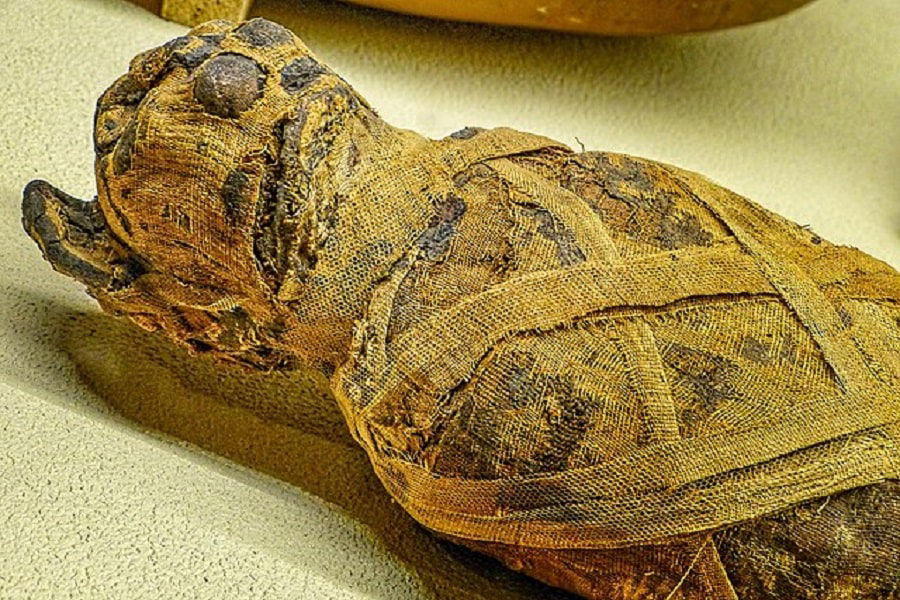
Why did Egyptians have Cat Mummies?
In ancient Egypt, cats were mummified for several reasons. There have been mummified cats discovered at Bastet’s cult center Bubastis, though they haven’t exclusively been discovered in temples. Many cat mummies have been found in personal tombs as recently as November 2022.
Dated to around 717 BCE and 339 BCE, the burials had been conducted in a tomb complex near the pyramid of pharaoh Userkaf. Though seemingly insignificant compared to his successors that ushered in the popularity of Ra, Userkaf founded Egypt’s Fifth Dynasty. Researchers believe that the tomb was exclusively used to bury cats and may have been one of the many pet cemeteries of the ancient world.
Cats were significant both socially and religiously. They were beloved pets as much as they were sacred creatures. While a cat mummy can be regarded as a pet that has passed on, a cat mummy can equally be a holy offering. It depends on the setting and the intention with which the cat was mummified.
The Dark Side of Cat Mummification
Later in Egyptian history (between 330 BCE and 30 BCE), cats were bred in special complexes for the sole purpose of becoming mummies. It was a morbid and, according to evidence, a seemingly widespread practice. Kittens were most frequently used in these instances. Much of the time, kitten mummies were sanctified and offered at a temple or sold to individual buyers.
Then, there are instances of empty mummies. The Smithsonian Institution describes linen wrappings in the shape of a kitten that holds no actual remains. The “mummy” would have been from between 332 BCE and 30 BCE. Though unusual, priests would conduct rituals that made the object an appropriate offering.
It is interesting to note that by the 3rd century BCE, Egypt no longer was a sprawling empire. It had been conquered by the Persians in the 5th century, and subsequently conquered by Alexander the Great in 332 BCE. Following Alexander’s death, the Macedonian general Ptolemy established the Egyptian Ptolemaic dynasty.
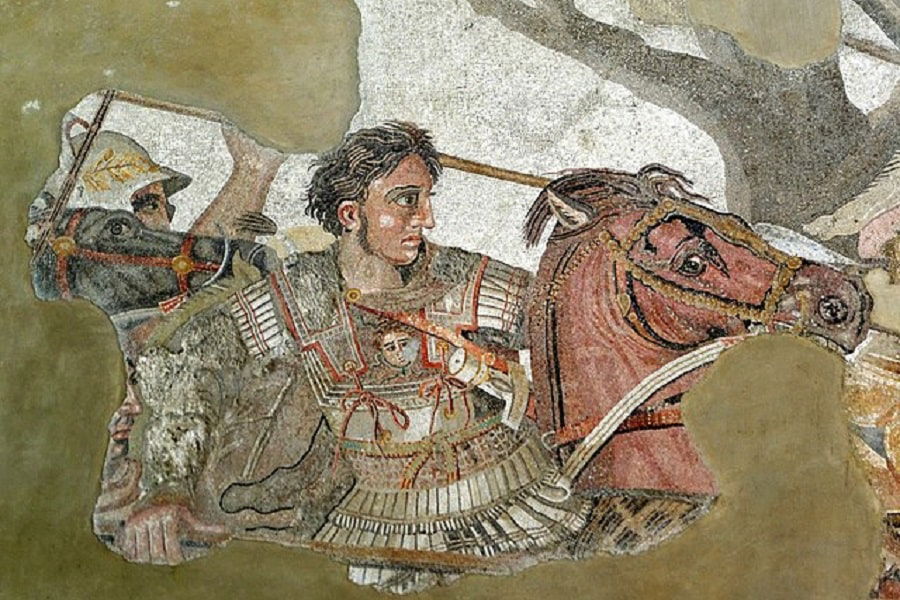
The Ptolemaic dynasty saw a rise of Greek polytheism and the hero cult of Alexander the Great. These were practiced alongside the traditional Egyptian religion. While it is unknown why there was an emergence of cat breeding centers and empty feline mummies, one can speculate.
The conquest of Alexander the Great and the wars that followed his death was a period of unrest. There was likely an increase in cat mummies because of the public need to feel secure in tumultuous times. Alternatively, cat mummies were offered as thanks for prayers answered.
Once established by Ptolemy Soter I, the Ptolemaic dynasty was prosperous. Ptolemaic pharaohs built magnificent temples for the gods. The arts and sciences flourished; the Library of Alexandria was built. Perhaps cat mummies were not created from strife, but instead from success.
Egyptian Cats and the Sun God
One of the biggest throughlines with Egyptian cat gods is their relationship with a solar deity. More often than not, feline goddesses are the daughters of the sun god, Ra, and are called the Eye of the Sun. Consequently, these cat gods can also be defined as solar deities themselves.
In Egyptian art, many cat gods are also shown to have sun disks above their heads. The disk highlights their relationship with the sun itself. Furthermore, like the sun, cat gods also have a dual nature.
The sun is necessary for life, though in abundance – such as in the scorching desert heat or during a drought – the sun can be damaging. Cats aren’t necessary for life (depending on who you ask) but they are nurturing. Seeing a mother cat with her kittens is evidence enough. Though a cat has claws for a reason: don’t underestimate them.
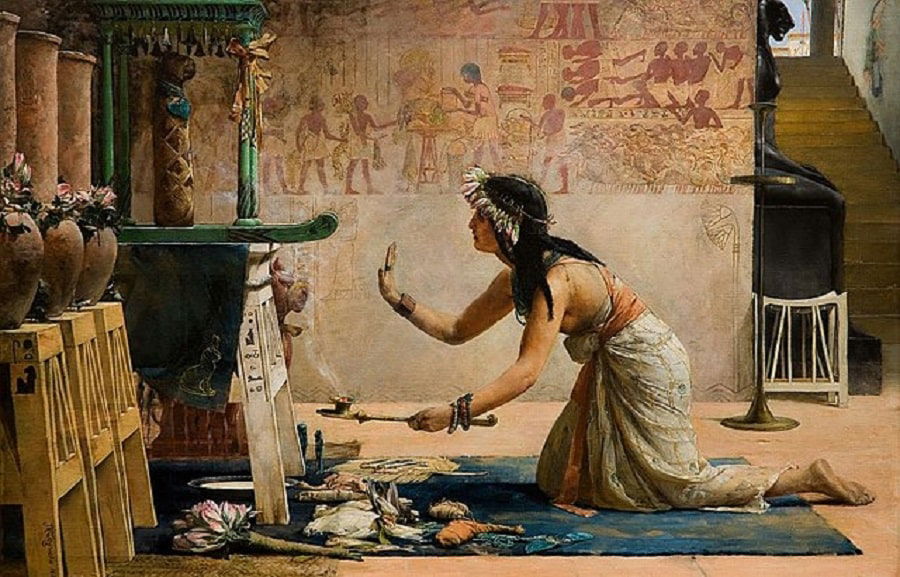
Cats Among Royals
Just as cats have an affiliation with the sun, they also have an affiliation with the finer things in life. Royalty, particularly pharaohs and their families, kept cats as pets. Thutmose, the eldest son of Pharaoh Amenhotep III and Queen Tiye, kept a cat named Mit. Meanwhile, Pharaoh Ramses II had a lion as his royal pet.
When kittens were raised in the households of the wealthy in ancient Egyptian society, they were spoiled. They received collars of precious metals and jewels, trinkets and toys, and ate table food alongside their owners. One wouldn’t have to search hard to find an archaic wall painting that depicts a house cat snuggled up to its favorite person.
The Big Cats of the Egyptian Pantheon
Cats in ancient Egypt were associated with protection, motherhood, ferocity, and order. To have one around was a blessing from the gods themselves. Below you’ll find a list of Egypt’s famous leonine goddesses (and a god, too)!
Bastet
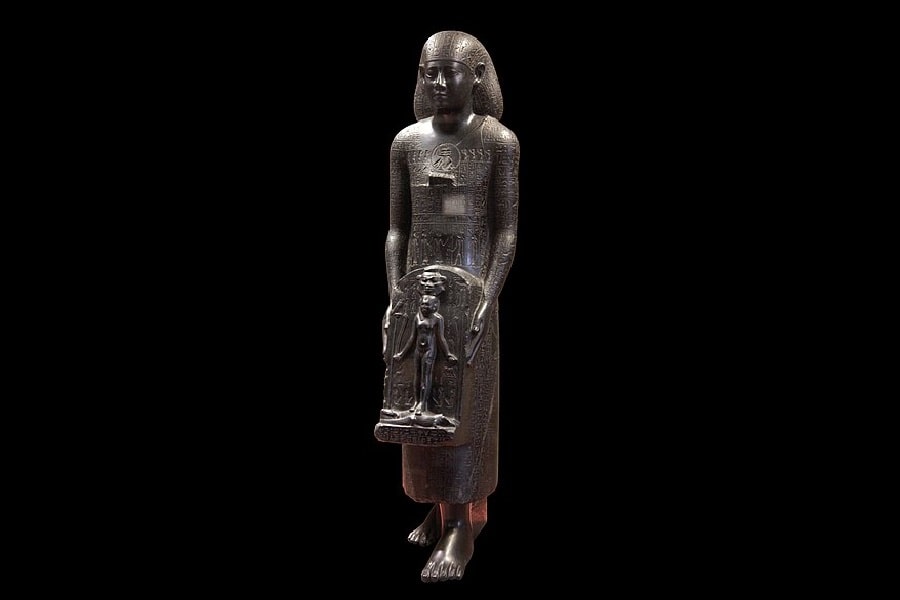
Realms: domestic harmony, the home, fertility, cats
Fun Fact: Of our cat gods, Bastet is the only one that can actually take the form of a cat
Mommy? Sorry. Mommy? Sorry. No, but literally: hear us out.
Bastet (alternatively Bast) went from being a ferocious lioness to a domestic cat with several kittens in tow. She’s the OG cat god of ancient Egypt and the only one of the bunch that can actually take on a feline form. If you aren’t impressed yet, just wait!
As the main cat goddess, Bastet embodied the duality of cats. She has violent tendencies, though most worshippers brush that aside in favor of her more nurturing aspects. In fact, Bastet’s earliest depictions show her as a lioness; it isn’t until later on that she gains a cat’s head. However, this isn’t the downgrade one might think it is.
When Bastet became domesticated, she had a new realm of influence. She became the protector of the home and mothers. More than that, Bastet kept harmony in the home.
One of the most famous offerings made to Bastet is the Gayer-Anderson cat, an embodiment of feline elegance. The Gayer-Anderson cat is a bronze statue from Egypt’s Late Period (664-332 BCE) adorned with gold ornaments. It is intricate, handsomely crafted, and just a good-lookin’ statuette. The Gayer-Anderson cat is just one among many votive offerings to Bastet.
The cult center of Bastet was Bubastis in the Nile Delta. Bubastis is known as Tell-Basta in Arabic and Per-Bast in Egyptian. The city peaked during the 22nd and 23rd Dynasties when Bubastis became the home of the royal family.
In her cat form, Bastet would fiercely defend her father from Apep, the serpent demon of chaos. Over time, this role became associated with the menacing Sekhmet.
Sekhmet
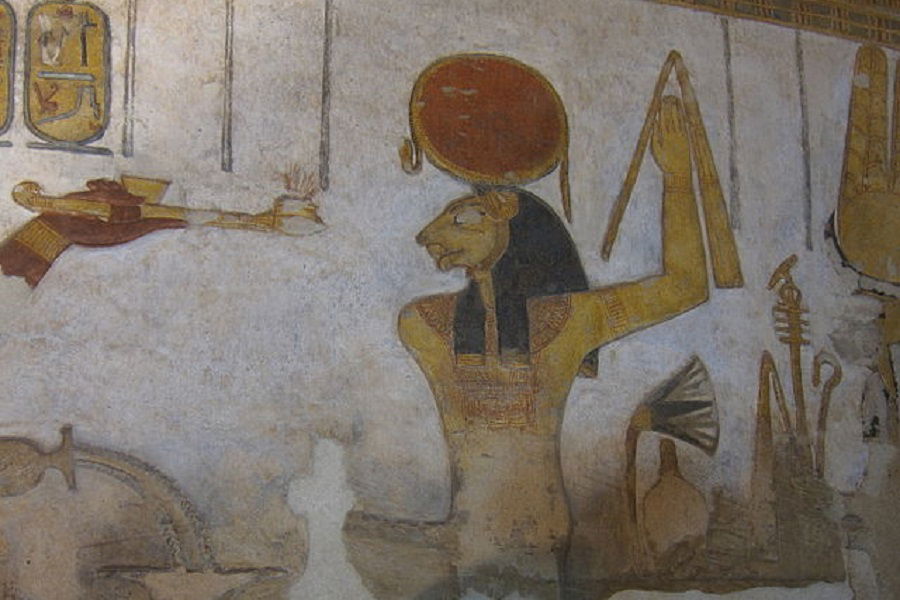
Realms: war, destruction, fire, battle
Fun Fact: Sekhmet is one of the honored “Eyes of the Sun”
Up next is Sekhmet. We love Sekhmet. She stepped up as the fierce protector when Bastet took maternity leave and ruled with an iron fist…or claw. You know how it is. Thanks to her natural inclination towards ruthlessness, Sekhmet is one of many gods on the list with a leonine form.
That’s right: there’s no house cat here. You won’t come across any image of Sekhmet as a mother cat nursing a litter. She’s too busy waging war against the demons of the night.
Sekhmet (also spelled Sachmis, Sakhmet, Sekhet, and Sakhet) is widely considered Bastet’s twin. Together, they represent duality: life and death, mercy and wrath, submission and domination. Likewise, the sisters embody Egypt itself. While Bastet represented Lower Egypt, Sekhmet was Upper Egypt.
The goddess Sekhmet is usually depicted as a lioness and protector of Ra. Both Bastet and Sekhmet are daughters and consort of the sun god Ra, sharing the title with Hathor and sometimes Satet. Sometimes, their father-husband is actually Ptah: it depends entirely on who the chief god is at the moment.
In Sekhmet’s most famous myth, she was so bloodthirsty that Ra – or Thoth – had to get her drunk enough to sleep so that she would stop slaughtering mortals. If they hadn’t, she would have destroyed humanity. You know, calling her “Mistress of Dread” makes much more sense now.
The cult center of Sekhmet was in Memphis, though she also had a large following in Taremu (Leontopolis). Libations were regularly given in Sekhmet’s honor, and a golden aegis was one of many objects attributed to her cult. At some point in time, live lions were kept in temples dedicated to her and her son, Maahes.
Mafdet

Realms: capital punishment, the law, kings, physical protection, protection against venomous animals
Fun Fact: Mafdet was known to only hunt at night
Earlier we mentioned how cute cats were. Sure, cats are cute, but they’re more than just pretty faces. That’s where Mafdet comes in.
The goddess Mafdet (also Mefdet or Maftet) is revered as the goddess of physical protection. She also enforces the law and doles out capital punishment. Thanks to her realms, Mafdet is most commonly depicted wielding a staff of office.
The ancient Egyptians saw Mafdet as a swift-footed cheetah, though there are some depictions of the goddess as a mongoose instead. By the time of the New Kingdom, Mafdet oversaw a realm of Duat (the Afterlife) where the enemies of the pharaoh would go. Far from a good time in the Land of Reeds, the traitors would get beheaded by the goddess.
Mafdet was known to accompany the gods, particularly Ra, and fend off poisonous serpents and scorpions. With so many battle-hardened felines in Ra’s entourage, Apep needs to look out! It was said that Mafdet paid the same respect to pharaohs, guarding the kings against harm. She would go as far as to tear out the heart of evil-doers and present it as a gift to the sitting pharaoh.
In all, while the jackal-headed Anubis was celebrated as the messenger and attendant of the gods, Mafdet was the guard and executioner. She may not have been a lion like the other deities on our list, but her punishment was swift.
Mut
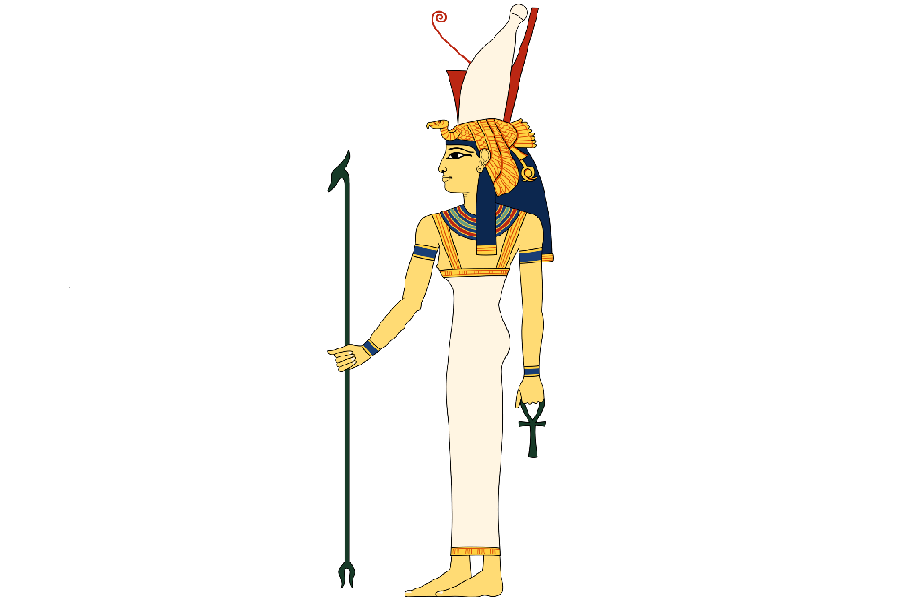
Realms: creation, motherhood
Fun Fact: Mut means “mother” in Ancient Egyptian
Mut (alternatively Maut and Mout) is the mother goddess of Egyptian mythology. It is no wonder that one of her forms is that of a mother cat. Though, that isn’t Mut’s norm. She is usually shown to be a beautiful woman wearing the double crown of Egypt, the pschent.
As time went on, Mut eventually adopted some attributes of Sekhmet and Bastet. Her gradual development into a woman with a feline head came once Mut melded with the aforementioned cat goddesses. Ancient Egyptians believed that Mut had a significant protective function besides her role in creation.
Mut is a part of the Theban Triad, joined with her husband, Amun-Ra, and their son, the lunar god Khonsu. Her popularity peaked during the Middle and New Kingdoms of ancient Egypt.
READ MORE: Amun: The Hidden King Of Gods In Ancient Egypt
Maahes
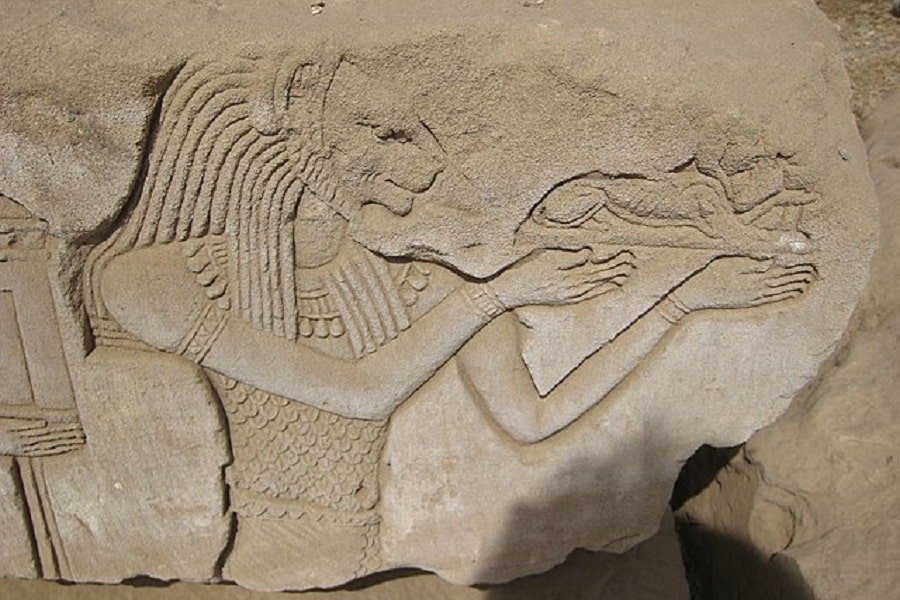
Realms: war, devouring captives, storms, the sun’s heat, blades
Fun Fact: Maahes’ epithets include “Lord of Slaughter,” “The Scarlet Lord,” and “The Lord of the Massacre”
As you can tell from Maahes’ epithets, this lion god means business. Maahes (also Mahes, Mihos, Miysis, Mysis) is the son of the creator god Ptah – or Ra, depending on who the chief god was – and either Bastet or Sekhmet. No matter his parents, he certainly got his mother’s looks. It can also be argued that if Sekhmet were his mother, Maahes also got her attitude.
Like many cat gods, Maahes has a leonine head and a human body. He was largely worshipped in Bubastis and Taremu, the centers of Bastet and Sekhmet respectively. Additionally, Maahes’ affinity for war and devouring captives has caused historians to draw parallels between him and the Nubian deity, Apedemak. Though it is unknown if Apedemak was always a cat god, Maahes certainly was.
Called the Lion Prince by the devout, Maahes was believed to have fought Apep beside Ra. The entire thing turned out to be a family affair. Moreover, despite not having a severe consequence on ancient Egyptian life during peacetime, Maahes would regularly be depicted as divinely regal in ancient Egyptian art. For someone who had an appetite for man flesh, no one would suspect it looking at a statue of him.
Cat Gods in Other Cultures
Cat gods didn’t just exist in the Nile Valley. Fierce felines were a staple of many ancient civilizations. From the cat god Li Shou of the ancient Chinese pantheon to the witch goddess Hecate of ancient Greece, there are plenty of other cat gods in other cultures. It isn’t just a coincidence, either.
With ferocity, loyalty, and a fabulous coat, of course, many deities would go on to adopt a feline form. Domestication of early felines began in the Near East, in the Fertile Crescent of the Neolithic period. Therefore, feline domestication aligns with the development of agriculture in the region. Wild cats were trained to guard crops and grain storage against unwanted visitors.
Cats played a vital role in the survival of early men. Domestic cats were charged with catching rodents, snakes, and other vermin. The cats of today aren’t too different. Heck, there’s even proof that modern cats can fight off bears. If cats nowadays can do that, one can only imagine how fearless their ancestors were.